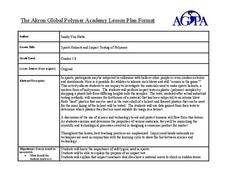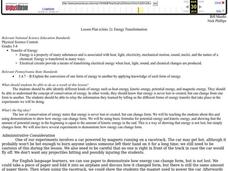Curated OER
Survival
Students determine the best material from which to make a jacket to keep the body warm in a cold, dry, windy climate. This task assesses the student's abilities to perform an entire investigation.
Foundation for Water & Energy Education
How Can a Dam Affect a River? Activity B
Second in a pair of activities, young ecologists continue to examine the food pyramid of a freshwater ecosystem. They take a look at the food pyramid drawn in Activity A and consider what would happen if a reservoir was created on the...
Curated OER
Sports Helmets and Impact Testing of Polymers
Learners examine the importance of good quality safety gear. In this investigative lesson, students will tests various polymers, collect data, and analyze the data to determine which polymer is best for safety helmets. They will design a...
Curated OER
Wilderness Survival: A Field Practicum
Young scholars are provided with hands-on-field testing of authentic applications from principles pertaining to: Psychology A. Develop a positive, can-do attitude with a high degree of self-reliance that is transferable to human...
Curated OER
Wilderness Survival: A Field Practicum
Learners use hands-on field-testing of authentic application from principles pertaining to: Psychology- A. Develop a positive, can-do attitude with a high degree of self-reliance that is transferable to human interactions outside of the...
Curated OER
Introduction to the Periodic Table
Eighth graders investigate the different elements of the Periodic Table. For this chemistry lesson, 8th graders pick an element to research, then present to the class using a powerpoint presentation or a poster.
Curated OER
Waste Aggregates and Material Properties
Students define specific waste materials that could be used as aggregate in concrete. In this aggregate and waste lesson plan, students brainstorm on how to incorporate waste in construction and define different aggregate materials.
Curated OER
Energy
Young scholars distinguish between kinetic an potential energy. They recognize that energy is conserved when changing from one form to another. Students compare the scientific meaning of work with its everyday meaning.
Curated OER
Electrical Noise and Interference
For this electronics worksheet, students identify and differentiate the different types of noise. They complete 4 short answer questions about the topic.
Curated OER
Biodiesel Combustion and Its Influences in NOx Emissions
Tenth graders evaluate the physical mechanisms that cause a change in NOx emissions. In this combustion lesson, 10th graders participate in a research project. Students create a presentation of their findings.
Curated OER
Using Radiosonde Data From a Weather Balloon Launch
Student use radiosonde data from a weather balloon launch to distinguish the characteristics of the lower atmosphere. They learn the layers of the atmosphere. They graph real atmospheric data.
Curated OER
Energy Transformation
Young scholars identify different kinds of energy such as heat energy, kinetic energy, potential energy, and magnetic energy. They investigate the concept of conservation of energy.
Curated OER
Survival Still
Students explain how to desalinate water using solar energy. In this solar lesson plan students complete a lab activity and explain capillary water.
Curated OER
An Introduction To Material Sciences
Young scholars investigate the concept of molecular structure. They describe the behavior of simulated molecules and identify any dislocations in crystalline structures. They also define various related vocabulary words and use them in...
Curated OER
Science Word Search
In this science worksheet, students look for the words that are related to the theme of the sheet in the word search. They also work on spelling skills.
Curated OER
CEENBot Soccer
Students research the history and uses of the different elements in the periodic table. In this chemistry lesson plan, students explain the significance of an element's valence electrons. They create a multimedia presentation of an...
Texas Education Agency
Texas Gateway: Heat and Heat Transfer Methods: Conduction
By the end of this section, you will be able to calculate thermal conductivity, observe conduction of heat in collisions, and study thermal conductivities of common substances.
Other
Fact index.com: Thermal Conductivity
Fact-Index.com offers an excellent site on thermal conductivity. Includes table of contents, hyperlinked terms, and formulas.
OpenStax
Open Stax: College Physics: Conduction
In this section of the textbook, learn about how heat is transferred by conduction. Section explores how to calculate thermal conductivity and studies the thermal conductivities of common substances. Also included are problems with...
Khan Academy
Khan Academy: What Is Thermal Conductivity?
Read this article to learn how to determine the rate at which heat conducts through a material.
Georgia State University
Georgia State University: Hyper Physics: Thermal Conductivity
Lists thermal conductivity values for a variety of topics. The link "Heat conduction discussion" on this page displays an equation for calculating the rate of thermal conduction using these conductivity values.
TeachEngineering
Teach Engineering: To Heat or Not to Heat?
Students are introduced to various types of energy with a focus on thermal energy and types of heat transfer as they are challenged to design a better travel thermos that is cost efficient, aesthetically pleasing and meets the design...
CK-12 Foundation
Ck 12: Physics: Thermal Properties Study Guide
A study guide for concepts related to thermal energy.
American Chemical Society
Middle School Chemistry: Heat, Temperature, and Conduction
Explore heat, temperature, and the conduction of thermal energy through different materials.
























